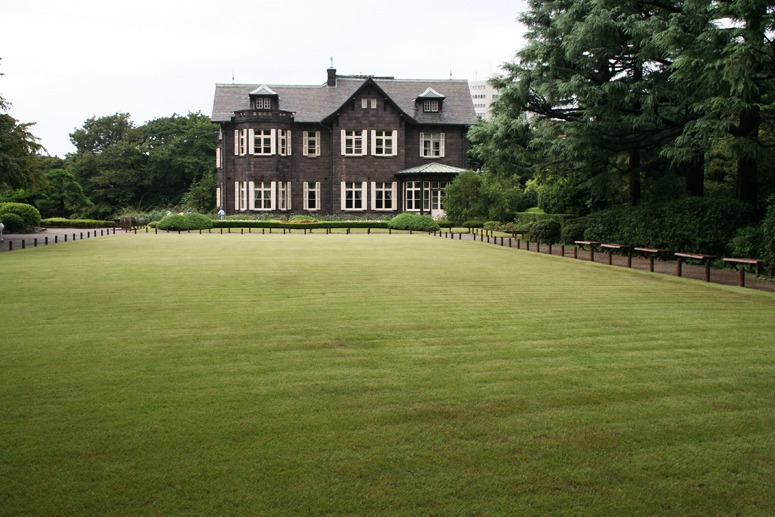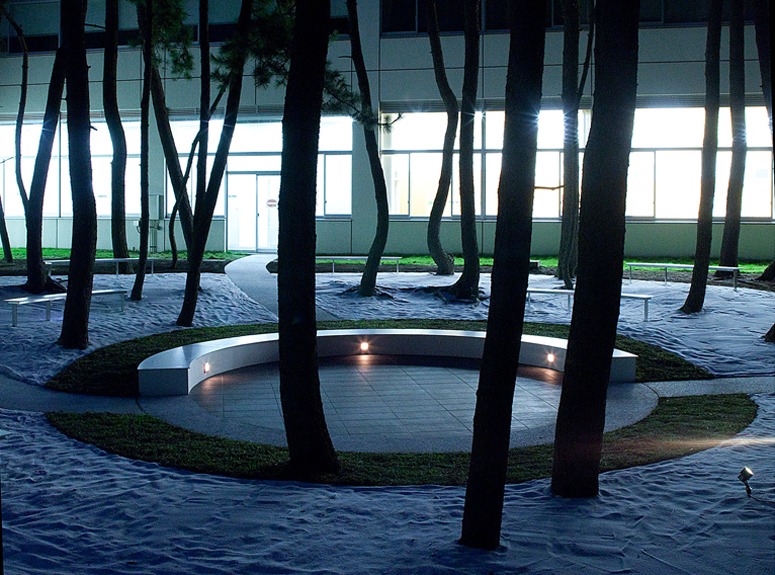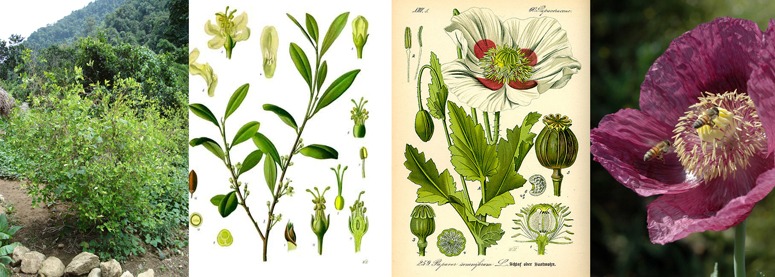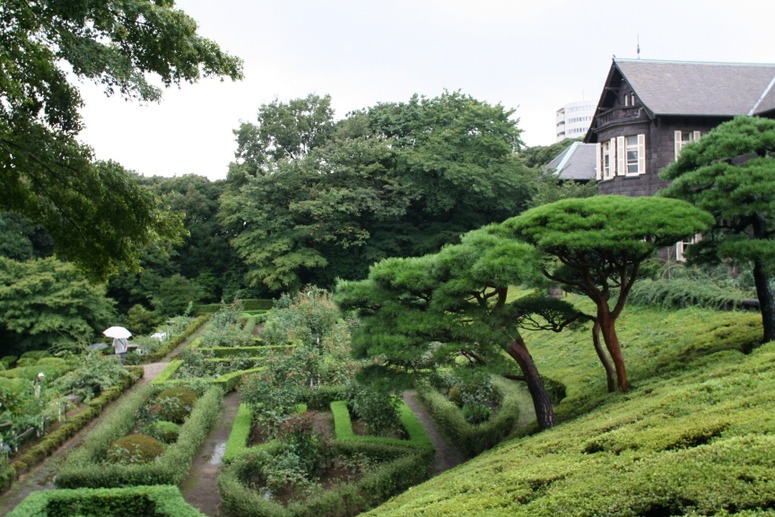
Please guess the continent, the country and the city (and if you know, please don’t give the answer at once!)
Author Archives: Tom Turner
Context sensitive landscape and garden design in Japan, by Haruko Seki/Studio Lasso Ltd
 Japan was the first Asian country to modernise its industry but always wanted to retain its unique identity. This turned out to be more difficult for buildings than for gardens. Haruko Seki is a Japanese landscape architect based in London. Perhaps for this reason, she has a keen eye for something essentially Japanese which is not sentimentaly ‘Old Japan’ We saw this in her Silver Moonlight Garden at the 2008 Chelsea Flower Show and are pleased to see it again in the above photograph of the Garden of Pine Woods for Niigata Seiryo University Campus, Niigata City, Japan (completed 2010). The courtyard was designed to become a central event stage and a space where everyone can meet. The structural form gleams softly through the shadow of pines, reflecting and enhancing their beauty. There is a Wabi-Sabi combination of purity with imperfection, because the trees do not allow perfectly complete circles. Sitting beneath the colling shade of pine trees is a pleasant activity in the hot humid shade of a Japanese summer. It is a context-sensitive design, functionally, climatically, culturally and aesthetically. The V-sign is also a context-sensitive gesture. In England it symbolises vulgar aggression (with the palm facing backwards) and victory, as in the Churchill salute, with the palm facing forwards. In Japan and much of East Asia, it became associated with peace and happiness, after the 1972 Olympic Games.
Japan was the first Asian country to modernise its industry but always wanted to retain its unique identity. This turned out to be more difficult for buildings than for gardens. Haruko Seki is a Japanese landscape architect based in London. Perhaps for this reason, she has a keen eye for something essentially Japanese which is not sentimentaly ‘Old Japan’ We saw this in her Silver Moonlight Garden at the 2008 Chelsea Flower Show and are pleased to see it again in the above photograph of the Garden of Pine Woods for Niigata Seiryo University Campus, Niigata City, Japan (completed 2010). The courtyard was designed to become a central event stage and a space where everyone can meet. The structural form gleams softly through the shadow of pines, reflecting and enhancing their beauty. There is a Wabi-Sabi combination of purity with imperfection, because the trees do not allow perfectly complete circles. Sitting beneath the colling shade of pine trees is a pleasant activity in the hot humid shade of a Japanese summer. It is a context-sensitive design, functionally, climatically, culturally and aesthetically. The V-sign is also a context-sensitive gesture. In England it symbolises vulgar aggression (with the palm facing backwards) and victory, as in the Churchill salute, with the palm facing forwards. In Japan and much of East Asia, it became associated with peace and happiness, after the 1972 Olympic Games.

Images and information on Garden of Pine Woods for Niigata Seiryo University
Opium and cocaine as recreational garden plants and drugs

Growing Papaver somniferum (right pics) in your garden is legal in the UK but not in the US. Converting it to opium or morphine is illegal in both countries. Erythroxylon coca (left pics) is the source of cocaine, which was a legal ingredient in Coca Cola until 1903. Opium was banned in China, in 1799. The British fought a war to have it re-legalised, which happened in 1860. The disadvantages of opium and cocaine are well known but, one wonders, might their worldwide re-legalisation bring any advantages? Yes: (1) the wicked drug dealers would be put out of business (2) recreational drugs could be taxed, like alcohol, to raise government revenues (as American states are increasingly doing with sales taxes on cannabis) (3) the US and UK prison populations, as examples, could be halved (4) the Taliban could be put out of business and the coalition of the increasingly-unwilling could withdraw from Afghanistan and stop smashing up ancient villages with Predator drones (5) innocent drug users would not be poisoned by impure contaminated drugs (6) countries like Columbia, Bolivia, Brazil, Peru and Mexico would benefit from the demise of their drug cartels, criminal gangs and private armies – the drug trade is immensely harmful to civil society in the producer countries (7) sex workers with a drug habit to fund could turn to healthier and more productive occupations (8) crime could he halved, because funding drug purchases is the predominant motive for property-related crime (9) police relieved from ‘the war on drugs’ could prevent more socially harmful crimes – and police corruption would be reduced (10) with fewer wars to fight, the US and the UK could begin to re-rebalance their budgets.

My own experience of taking dangerous drugs is as follows (1) smoking – and inhaling – tobacco as a student (2) limited use of orally administered alcoholic drinks as an adult (3) I was once given a marijuana joint. If it contained any of the illegal substance I did not notice the effect. But the scene is engraved in my memory. Mustafa, a girl and myself were at the top of a deserted Roman amphitheatre at midnight. The mountains to the north and the glittering sea to the south were bathed in moonlight. We laughed a lot and our voices rang round the marble amphitheatre. The location (Side, Turkey) is shown in Sean O’Sullivan‘s photograph. Though I did not become addicted to drugs, I did acquire a serious lifelong addiction to ancient sites, beautiful landscapes and laughter. Since this blog post is published on Christmas Day, it is worth remembering that the date of Christmas probably derives from pagan celebrations of the solstice (eg the Roman Saturnalia) and that sacramental wine is used at Mass.
Happy Christmas from Gardenvisit.com to all our readers
The landscape setting of Dun Carloway Broch, Lewis, Outer Hebrides
 Brochs are a unique building form, dating from the 1st century BC and indigenous to Scotland. They had internal wooden floors and they were inhabited. This is clear. But how they were located and why they were built is unclear. Gordon Childe interpreted brochs as fortifications from which chiefs ruled subject populations. Since no evidence for this could be found, this was followed (in the 1980s) by a theory that they were prestige dwellings for important families, but again there was a lack of evidence and it is often the case that brochs are not located in good agricultural land. But many brochs do have significant positions in the landscape, near cliffs, in valleys and by narrow stretches of water. This suggests, to me, that like so-called hill-forts and stone circles, they had a symbolic and aesthetic role in proclaiming that an area of land was in the ownership of a clan of closely related families. Brochs are early examples of Scottish landscape architecture.
Brochs are a unique building form, dating from the 1st century BC and indigenous to Scotland. They had internal wooden floors and they were inhabited. This is clear. But how they were located and why they were built is unclear. Gordon Childe interpreted brochs as fortifications from which chiefs ruled subject populations. Since no evidence for this could be found, this was followed (in the 1980s) by a theory that they were prestige dwellings for important families, but again there was a lack of evidence and it is often the case that brochs are not located in good agricultural land. But many brochs do have significant positions in the landscape, near cliffs, in valleys and by narrow stretches of water. This suggests, to me, that like so-called hill-forts and stone circles, they had a symbolic and aesthetic role in proclaiming that an area of land was in the ownership of a clan of closely related families. Brochs are early examples of Scottish landscape architecture.
Thank you to Maciomhair for his beautiful black and white photograph of Dun Carloway Broch in Scotland’s Outer Hebrides. The building form made good use of local materials and gave a high level of protection from wind and rain. Since travel by boat was easier than travel on land, the west coast of Scotland had relatively good links with Celtic Europe. The crofts on the left of the photograph are a survival of a medieval building-and-farming settlement type. When the brochs were built, other families lived in circular huts with mud or stone walls and thatched roofs.
Garden history as a word-and-image subject
John Dixon Hunt has edited journals on Word and Image and Studies in the History of Gardens and Designed Landscapes. I am an enthusiastic supporter of the link between the two disciplines, both of which are comparatively modern. As a practitioner, Ian Hamilton Finlay is notable for combining words with garden images. But the subject is very much larger than this and I would like to see schools and universities introducing courses in word and image communication. The Ancient Egyptians scarcely distinguished between the words and images and advent of electronic publishing will re-establish these links. The adage that ‘A picture is worth a thousand words’ is thought to come from an article about the use of images in advertisements (in a 1921 issue of Printers’ Ink). There is a particular need for word-and-image specialists in publishing and in garden history but they would surely would find jobs in many industries. I am puzzled by the limited graphic skills of most book editors and most garden historians. They need to be able to draw, both by hand and with graphic software, and they need to be able to use words to explain and analyze visual designs. And they need practical experience of photography and picture research. Our multi-media world requires multi-media skills. Courses in ‘media studies’ are too much like courses in ‘English literature’. They deal with criticism more than with creativity and technology. Graphic designers are interested in the topic but tend to have more skill with images than with words.
This post was prompted by reading a book on Baroque garden cultures: emulation, sublimation, subversion ed Michel Conan (Dumbarton Oaks, 2005). I enjoyed it. Conan is an erudite and interesting man but his skills are more with words than with images, while few periods in the history of art are as much in need of a word-and-image approach as the Baroque. There is good explanation of images in the accompanying text but the links between words and images are difficult to follow. For example, an old plan of Chantilly (Conan’s Fig 1) is used to make the points that ‘the garden was not subordinated to the house, that it was off the house’s axis, that its design had not been made to be seen from a particular room in the house, nor the basons to mirror it’. A specially drawn plan could have highlighted the house, the axis, the rooms and the basons.
The BBC has been broadcasting some brilliant word and images studies, but without the images. They should convert the History of the World in 100 Objects to a multi-media format.



